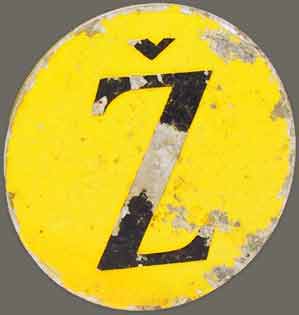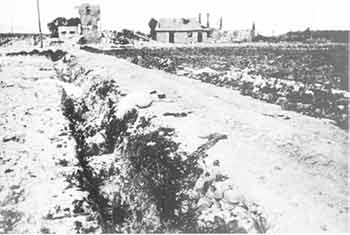Concentration Camps: Jasenovac
After Germany and its Axis allies invaded Yugoslavia in April 1941, the Nazis permitted the fascist and terrorist Ustaša organization to found the Independent State of Croatia (Nezavisna Država Hrvatska). The new regime was highly dependent upon German support for survival.
Targeted Populations
Badge for JewsThe territory of the Independent State of Croatia included two constituent units of former Yugoslavia, Croatia and Bosnia-Herzegovina, with a total population of about 6.3 million. More than half of the population, or 3.3 million, were ethnic Croats, most of them Catholic. The 1.9 million Serbs were the largest ethnic minority. Most of them were Serbian Orthodox and some were of the Uniate faith. Other minorities included approximately 700,000 Muslims, 40,000 Jews, and 30,000 Roma (Gypsies).
During the spring and summer of 1941, the Ustaša regime enacted racial laws aimed at Jews and Roma and launched a brutal campaign to dispossess, persecute, and murder large numbers of Serbs. Ustaša units, often encouraged by Catholic clergy, carried out a program of compulsory conversion of Orthodox Serbs to Catholicism; resistance often resulted in murder. Some Serbs, particularly members of the elite, were not even offered the option of conversion to avoid being killed.
The Concentration Camps
The Ustaša authorities established numerous concentration camps in Croatia between 1941 and 1945. These camps were used to isolate and murder Serbs, Jews, Roma, Muslims, and other non-Catholic minorities, as well as Croatian political and religious opponents of the regime. The largest of these centers was the Jasenovac complex, a string of five camps on the bank of the Sava River, about 60 miles (97 kilometers) south of Zagreb. Although further research may yield more exact figures, current estimates place the number of victims murdered by the Ustaša in Jasenovac during World War II between 56,000 and 97,000.
The Ustaša established Croatia’s first concentration camps in the spring of 1941. Among them were Koprivnica, Pag Island, Jadovno, Krušcica (located in Bosnia-Herzegovina), Ðakovo, Tenje, and Loborgrad. By October 1942, the Ustaša authorities had closed all of these camps. Between August 1941 and February 1942, the Ustaša established the Jasenovac complex of camps—Krapje, Brocica, Ciglana, Kozara, and Stara Gradiška. Krapje and Brocica were closed in November 1941. Ciglana, Kozara, and Stara Gradiška were dismantled in April 1945 as the Ustaša fled the approaching Yugoslav partisans.
Many of the camp inmates died of starvation, exposure, and disease, or were murdered by the Ustaša guards. In addition, Ustaša authorities handed over approximately 7,000 Jews from Croatia and Bosnia-Herzegovina to the Nazis for deportation to Auschwitz, Bergen-Belsen, and other camps.
Collaboration with Germany
After Germany and its Axis allies invaded Yugoslavia in April 1941, the Nazis permitted the fascist and terrorist Ustaša organization to found the Independent State of Croatia. The new regime was highly dependent upon German support for survival.
Between 1941 and 1945, Germans and Ustaša killed approximately 32,000 Jews from Croatia. The precise number of Jews murdered in Jasenovac is not known, but estimates range between 8,000 and 20,000 victims. These numbers do not include Jews whom the Ustaša authorities turned over to the Germans for deportation to Auschwitz and other camps.
Victims
Further research on the victims of the Ustaša regime in Croatia during World War II is necessary to enable historians and demographers to determine more precisely the number of those who perished under the rule of the Independent State of Croatia.
Due to differing views and lack of documentation, estimates for the number of Serbian victims in Croatia range widely, from 25,000 to more than one million. The estimated number of Serbs killed in Jasenovac ranges from 25,000 to 700,000. The most reliable figures place the number of Serbs killed by the Ustaša between 330,000 and 390,000, with 45,000 to 52,000 Serbs murdered in Jasenovac.
Germans and Ustaša killed approximately 32,000 Jews from Croatia between 1941 and 1945. The precise number of Jews murdered in the Jasenovac complex is not known, but estimates range from 8,000 to 20,000 victims. These numbers do not include Jews whom the Ustaša authorities turned over to the Germans for deportation to Auschwitz and other camps.
Statistics for Romani victims are difficult to assess, as there are no firm estimates of their number in prewar Croatia and Bosnia-Herzegovina. The best estimates calculate the number of Romani victims at about 26,000, of whom between 8,000 and 15,000 perished in Jasenovac.
There are only loose estimates for the number of Croats murdered by the Ustaša. This group included political and religious opponents of the regime, both Catholic and Muslim. Between 5,000 and 12,000 Croats are believed to have died in Jasenovac.
There are no reliable statistics on the number of Muslim victims. The Muslims from Bosnia-Herzegovina were ethnic Slavs and spoke a variety of Serbian and Croatian dialects. Croatian nationalists as well as the radical Ustaša leaders perceived all Muslims in Bosnia-Herzegovina as Croats; the regime aimed to convert them to Catholicism. They were persecuted for religious and political rather than racial reasons.
Research
Since the end of World War II, political and ideological conflicts in the area have made the documentation and verification of victim statistics extremely difficult. To cover the trail of terror and murder, authorities of the Independent State of Croatia burned official records from the Jasenovac camps first in early 1943 and again upon evacuation in 1945.
Dependable statistics that do exist are based on the work of several historians who have used census records and other available documentation from German, Croatian, and former Yugoslav archives.
Sources: USHMM




